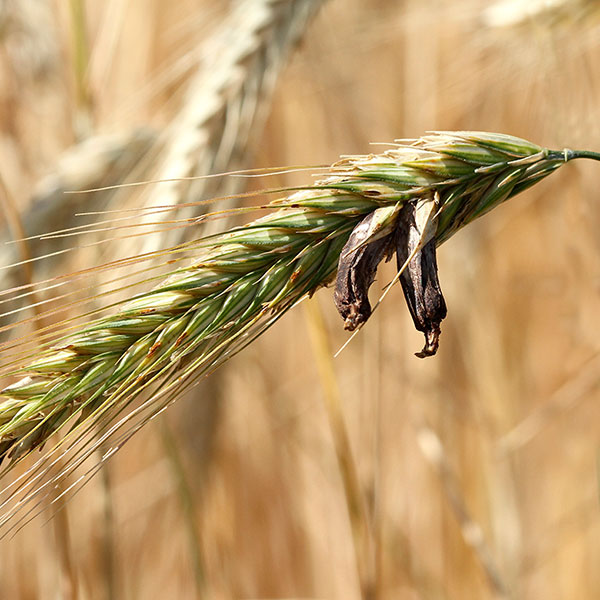DEBATE
Should genome editing continue to be regulated like genetic engineering?
Genome editing: is it a promising new method or are its dangers being underestimated? It’s currently regulated by the Gene Technology Act, but this is itself a matter of intense debate among experts.

Photo: Heiner H. Schmitt

Photo: zVg
For these reasons, new genetically edited crops should be treated differently from traditional GMOs. Almost 30 years of experience worldwide, on areas more than 100 times the arable land of Switzerland, have shown that there is no inherent risk from genetically modified crops, and there is no reason why this should be the case for the new genome-editing techniques that are more predictable and reliable than any previous genetic technology. Importantly, breeding using genome editing causes even fewer alterations to the genome than traditional mutation breeding that uses strong radiation – typically X-rays – or DNA-modifying chemicals. Both these techniques produce hundreds of unwatned mutations, but have never been considered a particular risk to consumers.
Consequently, new genome-edited crops should be evaluated according to their particular characteristics, not according to the genome-editing tools that were used to generate them. Gene editing results in small mutations that cannot be distinguished from natural ones, but this merely confirms the lack of reason to view these as potentially harmful, or to classify them as GMOs.
Didier Reinhardt is a biologist at the University of Fribourg and a member of the Forum for Genetic Research at the Swiss Academy of Sciences (SCNAT).
Gene editing should in future continue to be regulated by the Gene Technology Act, because it is clearly a genetic procedure. This is the only way that we can ensure transparency and freedom of choice. Genetic engineering involves interventions in the genetic material of animals and plants, using isolated cells in vitro. The great majority of people in the organic sector reject such methods, for ethical reasons and because of safety concerns. Consumers accordingly expect organic products to be free of any genetic engineering. This freedom of choice can only be maintained, however, if there is a labelling obligation with regard to genetically modified seeds and foodstuffs.
According to today’s laws, if you want to bring genetically modified plants onto the market, then you also have to provide detection methods that allow people to trace their origin. If genome editing is no longer regulated, these obligations will fall away. Even if it is difficult to prove that something has been subjected to genome editing, this is no reason not to regulate it. Organic products, for example, can only be differentiated from conventional foodstuffs by means of complicated analytical methods. Certifying organic products is therefore process-based, all along the value chain. Similarly, one could also declare genetically edited products in a transparent manner.
The risks associated with releasing genetically edited plants depend on how such species will cross with other varieties and wild species and propagate; we need to know whether they have toxic features, and how their cells have been altered. Accordingly, the conditions for ‘harmlessness tests’ should be adapted on a case-by-case basis. Given the scepticism of broad swathes of the population, before we put genetically modified organisms onto the market, we should take into consideration not just their safety and their usefulness to agriculture, but also their use to society. If they are non-allergenic and resistant to disease, they will presumably be more broadly accepted than herbicide-resistant types.
Monika Messmer is the head of the group ‘plant breeding’ at the Research Institute of Organic Agriculture (FiBL).

Photo: Heiner H. Schmitt

Photo: zVg
Our current legislation on genetically modified organisms (GMO) – the Gene Technology Act – is almost 20 years old, and therefore cannot be reasonably applied to a technology that has only been adopted in practice during the last decade. Genome editing is different from traditional genetic engineering techniques in one central point: It is targeted. In contrast to the techniques developed in the 1990s – the non-targeted insertion of DNA by bacterial transfer or particle bombardment – these new gene-editing techniques can be precisely directed to a single, predefined position in the genome of a plant. At this specific position, the DNA is modified, usually resulting in the partial or complete inactivation of the target gene. Rare off-target effects can occur, such as mutations at other positions in the genome, but these can easily be detected by whole-genome sequencing and thereby identified and eliminated.
For these reasons, new genetically edited crops should be treated differently from traditional GMOs. Almost 30 years of experience worldwide, on areas more than 100 times the arable land of Switzerland, have shown that there is no inherent risk from genetically modified crops, and there is no reason why this should be the case for the new genome-editing techniques that are more predictable and reliable than any previous genetic technology. Importantly, breeding using genome editing causes even fewer alterations to the genome than traditional mutation breeding that uses strong radiation – typically X-rays – or DNA-modifying chemicals. Both these techniques produce hundreds of non-targeted mutations, but have never been considered a particular risk to consumers.
Consequently, new genome-edited crops should be evaluated according to their particular characteristics, not according to the genome-editing tools that were used to generate them. Gene editing results in small mutations that cannot be distinguished from natural ones, but this merely confirms the lack of reason to view these as potentially harmful, or to classify them as GMOs.
Didier Reinhardt is a biologist at the University of Fribourg and a member of the Forum for Genetic Research at the Swiss Academy of Sciences (SCNAT).
Gene editing should in future continue to be regulated by the Gene Technology Act, because it is clearly a genetic procedure. This is the only way that we can ensure transparency and freedom of choice. Genetic engineering involves interventions in the genetic material of animals and plants, using isolated cells in vitro. The great majority of people in the organic sector reject such methods, for ethical reasons and because of safety concerns. Consumers accordingly expect organic products to be free of any genetic engineering. This freedom of choice can only be maintained, however, if there is a labelling obligation with regard to genetically modified seeds and foodstuffs.
According to today’s laws, if you want to bring genetically modified plants onto the market, then you also have to provide detection methods that allow people to trace their origin. If genome editing is no longer regulated, these obligations will fall away. Even if it is difficult to prove that something has been subjected to genome editing, this is no reason not to regulate it. Organic products, for example, can only be differentiated from conventional foodstuffs by means of complicated analytical methods. Certifying organic products is therefore process-based, all along the value chain. Similarly, one could also declare genetically edited products in a transparent manner.
The risks associated with releasing genetically edited plants depend on how such species will cross with other varieties and wild species and propagate; we need to know whether they have toxic features, and how their cells have been altered. Accordingly, the conditions for ‘harmlessness tests’ should be adapted on a case-by-case basis. Given the scepticism of broad swathes of the population, before we put genetically modified organisms onto the market, we should take into consideration not just their safety and their usefulness to agriculture, but also their use to society. If they are non-allergenic and resistant to disease, they will presumably be more broadly accepted than herbicide-resistant types.
Monika Messmer is the head of the group ‘plant breeding’ at the Research Institute of Organic Agriculture (FiBL).




